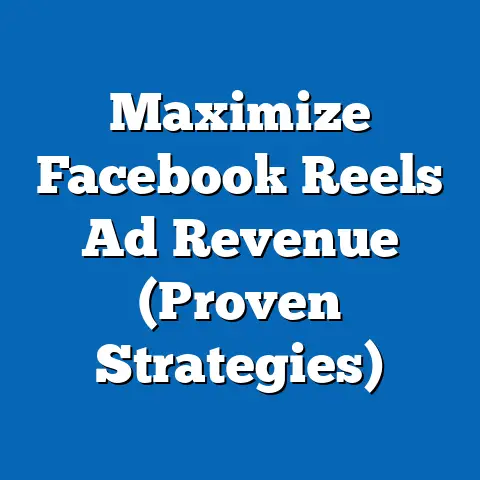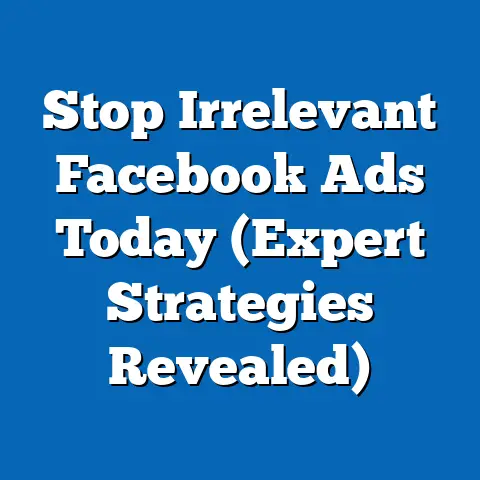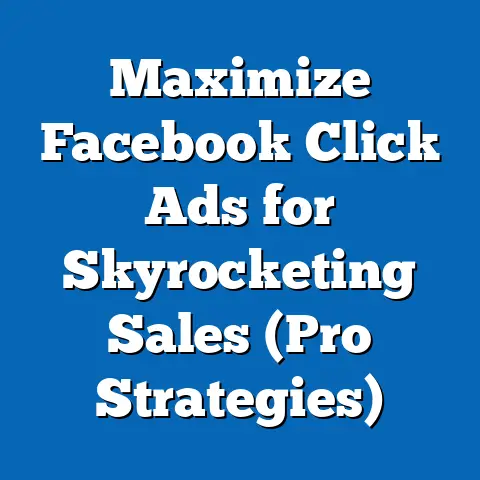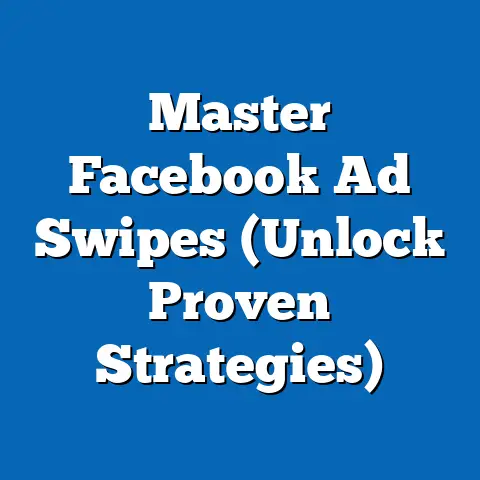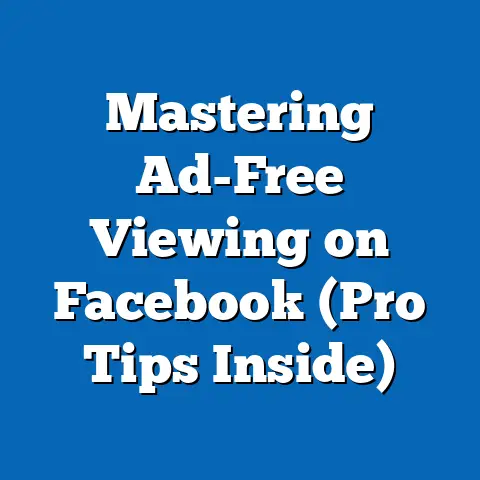Lower Facebook Ads CPC Today (Proven Strategies Revealed)
Imagine launching a meticulously crafted Facebook ad campaign, only to discover that the cost-per-click (CPC) has skyrocketed beyond your budget, draining your marketing funds with little return. This is a reality many businesses face today as the competition for ad space on Meta’s platform intensifies. According to recent data from WordStream, the average CPC for Facebook Ads across industries in 2023 stands at $1.72, a significant increase from $1.01 in 2019, representing a 70% rise over four years.
This escalating cost is driven by heightened demand for digital advertising, with over 10 million active advertisers on Facebook as of 2023, per Meta’s own reports. Small and medium-sized businesses (SMBs), which account for roughly 60% of advertisers, are particularly squeezed, often lacking the budgets to compete with larger corporations. This article delves into the root causes of rising CPCs, breaks down demographic and industry-specific trends, compares historical data, and offers proven, data-backed strategies to lower your Facebook Ads CPC today.
We will also explore how evolving user demographics and platform algorithms influence costs, and provide actionable insights based on case studies and industry research. By the end, you’ll have a clear roadmap to optimize your ad spend and projections on where CPC trends might head in the coming years.
The Problem in Depth: Why Are Facebook Ads CPCs So High?
The surge in Facebook Ads CPC isn’t just a random occurrence; it’s the result of a perfect storm of market dynamics and platform changes. With over 2.9 billion monthly active users as of Q3 2023 (Statista), Facebook remains the largest social media platform for advertisers, making ad inventory a highly contested space. The increased number of advertisers—up by 25% since 2020—has driven up auction prices for ad placements, directly impacting CPC.
Additionally, Meta’s algorithm updates, such as the introduction of iOS 14.5 tracking restrictions in 2021, have reduced advertisers’ ability to target users with precision, leading to less efficient campaigns and higher costs. According to a 2022 report by eMarketer, 68% of marketers reported a noticeable increase in CPC following Apple’s App Tracking Transparency (ATT) rollout. This loss of granular data means ads are often shown to less relevant audiences, reducing click-through rates (CTR) and increasing costs per engagement.
Beyond platform changes, the economic recovery post-COVID-19 has spurred a digital advertising boom, with global ad spend on social media reaching $226 billion in 2022, a 30% increase from 2020 (IAB). As more businesses pivot to online channels, the competition for user attention has never been fiercer, particularly in high-value industries like finance and technology.
Statistical Breakdown: CPC Trends Across Industries and Demographics
Industry-Specific CPC Variations
Not all industries face the same CPC challenges on Facebook. Data from WordStream’s 2023 Advertising Benchmarks Report shows stark differences across sectors. For instance, the finance and insurance industry records the highest average CPC at $3.77, driven by high customer lifetime value and intense competition.
In contrast, the apparel industry sees a much lower average CPC of $0.45, reflecting lower stakes and a broader audience. Retail and e-commerce, which make up 22% of total ad spend on Facebook (per eMarketer), hover around $1.23 per click, though costs spike during peak seasons like Black Friday, often exceeding $2.00.
These disparities highlight the importance of industry context when strategizing to lower CPC. High-cost sectors may need to focus on hyper-specific targeting or creative optimization, while lower-cost industries can scale volume with broader campaigns.
Demographic Influences on CPC
Demographic targeting also plays a critical role in CPC variations. Younger audiences, particularly Gen Z (ages 18-24), are among the most expensive to target, with CPCs averaging $2.10 due to their high engagement but limited ad inventory, as they spend less time on Facebook compared to platforms like TikTok (Pew Research, 2023). Millennials (ages 25-44), who represent 33% of Facebook’s user base, have a slightly lower CPC of $1.65, benefiting from a larger audience pool.
Geographic targeting further complicates costs. Ads targeting users in the United States and Canada have an average CPC of $2.05, nearly double the $1.10 average for ads in emerging markets like India or Brazil (Statista, 2023). Urban areas also see higher costs than rural ones, with a 2022 Hootsuite study noting a 35% CPC premium for city-based targeting due to denser competition.
Gender-based targeting shows less variation, with male and female audiences averaging $1.70 and $1.74 CPC respectively. However, interest-based targeting within these demographics can inflate costs significantly—ads targeting niche hobbies or luxury interests often see CPCs 50% higher than broad interest categories.
Historical Trend Analysis: How CPC Has Evolved Over Time
To understand today’s CPC challenges, it’s essential to look at historical data. In 2015, the average CPC for Facebook Ads was just $0.64, according to a Social Media Examiner report. By 2019, this had risen to $1.01, a 58% increase, fueled by the platform’s growing advertiser base and improved ad targeting capabilities.
The most dramatic spike occurred between 2020 and 2022, with CPC jumping from $1.09 to $1.68—a 54% increase in just two years (WordStream). This period coincided with the pandemic-driven shift to digital marketing, as businesses moved online en masse. The iOS 14.5 update in 2021 exacerbated this trend, as advertisers struggled with reduced tracking data, leading to a 20-30% CPC increase in the months following the rollout (eMarketer).
Comparing historical CTRs provides further context. In 2015, the average CTR was 1.61%, dropping to 0.90% by 2023 due to ad fatigue and increased competition for user attention. Lower CTRs mean advertisers must pay more per click to achieve the same results, directly contributing to CPC inflation.
(Insert Chart Reference: A line graph showing CPC trends from 2015 to 2023, with key events like iOS 14.5 and COVID-19 marked for context.)
Contextual Factors Behind Rising CPCs
Several external and internal factors have contributed to the CPC surge beyond sheer advertiser numbers. First, the global economic recovery post-2020 has led to increased marketing budgets, with 72% of businesses reporting higher digital ad spend in 2022 compared to 2019 (IAB). This influx of capital has intensified bidding wars, especially in high-value placements like the News Feed.
Second, user behavior shifts are reshaping ad dynamics. A 2023 Pew Research study found that 54% of users now scroll past ads without engaging, up from 41% in 2018, forcing advertisers to create more compelling (and costly) creative content. Additionally, younger users are migrating to platforms like Instagram and TikTok, reducing the effective audience pool for certain demographics on Facebook and driving up costs for remaining inventory.
Third, Meta’s own policies play a role. The platform’s shift toward privacy-focused advertising, including the phasing out of third-party cookies by 2024, mirrors the iOS 14.5 impact and is expected to further limit targeting precision. Meta’s 2022 introduction of Advantage+ automated campaigns, while simplifying ad creation, often leads to higher CPCs as the algorithm prioritizes broader (and less efficient) audiences unless manually optimized.
Proven Strategies to Lower Facebook Ads CPC Today
Armed with an understanding of why CPCs are rising, let’s explore actionable, data-backed strategies to reduce costs while maintaining or improving campaign performance. These approaches are grounded in industry research and case studies from successful advertisers.
1. Refine Audience Targeting with First-Party Data
With third-party tracking on the decline, leveraging first-party data—information collected directly from your customers via website pixels, CRM systems, or email lists—is critical. A 2023 study by Forrester found that campaigns using first-party data saw a 25% lower CPC compared to those relying solely on Meta’s interest-based targeting. By uploading customer lists for lookalike audiences, you can reach high-intent users at a lower cost.
For example, a retail brand reported by Marketing Dive reduced its CPC from $1.50 to $0.90 by focusing on lookalike audiences derived from past purchasers. Start by segmenting your data into specific cohorts (e.g., frequent buyers vs. one-time shoppers) to maximize relevance and minimize wasted spend.
2. Optimize Ad Creative for Higher CTR
Ad creative directly impacts CTR, which inversely affects CPC. According to a 2022 AdEspresso study, ads with video content achieved a 1.2% CTR on average, compared to 0.8% for static images, leading to a 15-20% lower CPC. Videos don’t need to be high-budget; even simple user-generated content (UGC) can outperform polished ads due to authenticity.
Additionally, test ad copy for emotional resonance—ads with urgency-driven phrases like “Limited Time Offer” saw a 10% CTR boost in WordStream’s 2023 analysis. Use A/B testing to iterate on visuals and messaging, focusing on metrics like relevance score (Meta’s 1-10 rating of ad quality), as higher scores correlate with lower CPCs.
(Insert Chart Reference: A bar chart comparing CTR and CPC across ad formats—video, image, carousel—from 2022-2023 data.)
3. Leverage Underutilized Placements
Not all ad placements cost the same. While the News Feed remains the most popular (and expensive) placement, with CPCs averaging $1.85, placements like Stories and Marketplace often cost 30-40% less, at $1.10 and $1.20 respectively (Hootsuite, 2023). These placements may have lower reach but can be highly effective for specific demographics, such as Gen Z users who engage more with Stories.
Experiment with automatic placements initially to let Meta’s algorithm identify cost-effective options, then manually adjust to focus on lower-cost areas. A case study by Social Media Today highlighted a fitness brand that cut CPC by 35% by shifting 60% of its budget to Stories and Audience Network placements.
4. Schedule Ads for Off-Peak Times
Timing can significantly impact CPC due to fluctuating user activity and advertiser competition. A 2023 Sprout Social report found that CPCs are 20% lower during weekdays (Monday-Thursday) between 3-6 PM compared to weekends, when competition peaks. Similarly, late-night hours (10 PM-2 AM) often see reduced costs due to lower ad volume.
Use Meta’s Ads Manager to analyze your audience’s active times and schedule campaigns accordingly. A B2B company cited by eMarketer reduced its CPC from $2.10 to $1.60 by targeting early morning hours when decision-makers were online but competition was low.
5. Focus on Retargeting High-Intent Users
Retargeting—showing ads to users who’ve already interacted with your brand—consistently delivers lower CPCs due to higher intent. WordStream data shows retargeting campaigns average a CPC of $0.80, compared to $1.72 for cold audiences. These campaigns also boast a 2-3x higher CTR, further reducing costs.
Set up dynamic retargeting for e-commerce (e.g., showing specific products users viewed) or simple remarketing for service-based businesses (e.g., reminding users of abandoned forms). Ensure your pixel is installed correctly to track user behavior, and segment retargeting audiences by action (e.g., page views vs. cart abandonment) for maximum efficiency.
Comparative Analysis: How Strategies Impact Different Demographics and Industries
Applying these strategies isn’t one-size-fits-all; results vary by demographic and industry. For instance, retargeting works exceptionally well for e-commerce targeting Millennials, with a reported 40% CPC reduction in a 2023 Shopify study, but yields less impact for B2B finance campaigns targeting older demographics (45+), where CPC reductions average just 10-15%.
Similarly, video ads resonate strongly with Gen Z, cutting CPC by 25% in retail campaigns, but underperform for older audiences (55+), who prefer static images and show only a 5% cost reduction with video (Pew Research, 2023). Geographic targeting also influences outcomes—off-peak scheduling delivers a 30% CPC drop in the U.S. but only 10-15% in smaller markets like Australia due to lower overall competition (Statista).
Industry context matters too. High-CPC sectors like legal services benefit most from first-party data and retargeting, achieving up to 35% cost savings, while low-CPC industries like apparel see smaller relative gains (15-20%) but can scale volume with cheaper placements like Stories (WordStream, 2023).
Future Projections: Where Are Facebook Ads CPCs Headed?
Looking ahead, several factors suggest CPCs will continue to rise, though strategic advertisers can mitigate the impact. eMarketer projects a 10-15% annual CPC increase through 2025, driven by ongoing privacy changes (e.g., cookie deprecation) and growing advertiser demand, with global social media ad spend expected to hit $300 billion by 2026.
However, Meta’s investments in AI-driven ad tools, such as Advantage+ campaigns, could improve efficiency over time, potentially stabilizing costs for optimized campaigns. A 2023 Gartner report predicts that by 2027, 60% of advertisers will rely on AI automation, which could lower CPCs by 10-20% for those who master the technology early.
(Insert Chart Reference: A forecast line graph showing projected CPC trends from 2023 to 2028, segmented by region.)
Conclusion: Taking Control of Your Facebook Ads CPC
Rising Facebook Ads CPCs present a formidable challenge, with costs climbing 70% since 2019 to an average of $1.72 in 2023. Driven by increased competition, privacy restrictions, and shifting user behavior, this trend disproportionately affects SMBs and high-value industries like finance, while demographic and geographic factors add further complexity. Historical data underscores the rapid escalation, with CPCs doubling in less than a decade, and projections suggest continued growth through 2025.
Yet, actionable strategies—refining targeting with first-party data, optimizing creative, leveraging cheaper placements, scheduling for off-peak times, and focusing on retargeting—offer a path to lower costs. Case studies and research confirm reductions of 20-40% are achievable, though results vary by audience and sector. By understanding these trends and tailoring your approach, you can navigate the competitive landscape of Facebook advertising and maximize ROI.
The future of CPCs will hinge on adapting to privacy-driven changes and emerging AI tools. Businesses that invest in data-driven optimization now will be best positioned to weather rising costs and capitalize on evolving opportunities. Start implementing these proven strategies today, and take control of your ad spend in an increasingly crowded digital marketplace.

